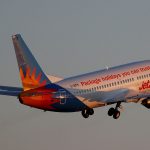The biggest rail strike in 33 years has left visits to City centres on a par with levels seen during COVID lockdowns, according to industry data.
Retail analysts Springboard said footfall in central London on the first day of the week-long disruption had endured the worst decline, on the previous Tuesday, of 27% by 1pm.
The measure for cities outside the capital averaged 11.2% though the impact was much less severe in market towns, Springboard said, as they saw a fall of just 2%.
Central London’s decline chimed with warnings there ahead of the action that many businesses in retail and hospitality faced grim losses at a time they can least afford them after two COVID-hit summers followed by the cost of living crisis.
‘Do not travel’ warnings – live updates on rail strikes
Springboard said it was clear that “major disruption to retail” had been caused.
Its insights director Diane Wehrle said: “The impact of train and tube strikes today on footfall is very clear to see, with a large proportion of people clearly working from home.
Ministers relax airport slot rules to help avoid flight cancellations
Cost of living: Scramble for value ranges as grocery inflation hits highest level since 2009
Rail strikes live: ‘Do not travel’ warnings as rail staff walk out – as poll shows public not behind them
“The drop in footfall in central London and regional cities means that the gap from the 2019 footfall level has widened considerably – to -49.2% and -29.8%, which are levels that are equivalent to those recorded during lockdown.
“In contrast in market towns the gap from the 2019 footfall level has narrowed to just -2.5% below 2019 and -13.4% in Outer London.”
Location technology firm TomTom reported that congestion levels at 11am were higher than at the same time last week in a number of urban areas.
They included London – from 38% on 14 June to 51% on Tuesday – Cardiff (from 24% to 29%), Liverpool (from 24% to 30%), Manchester (from 27% to 34%) and Newcastle (from 18% to 20%).
The data also shows that people travelling by car or buses in the capital between 6am and 10am needed an average of 72% more time compared to the 45% extra time needed on average during the past three Tuesdays.






















